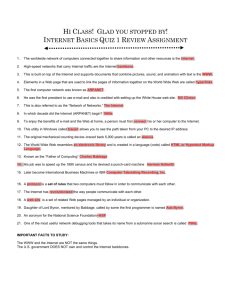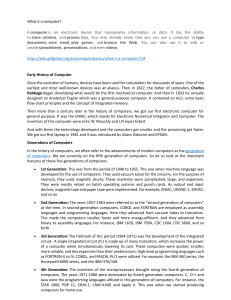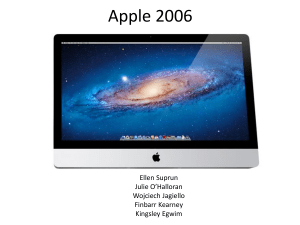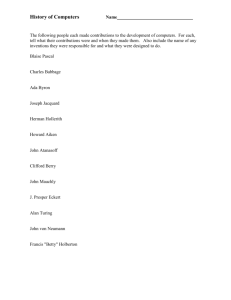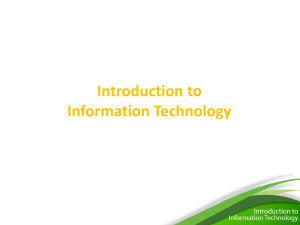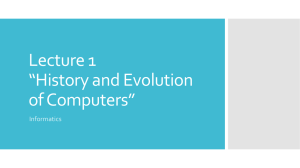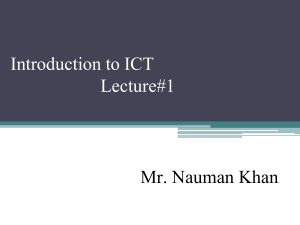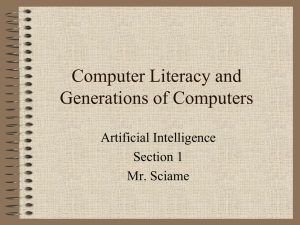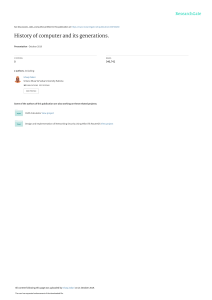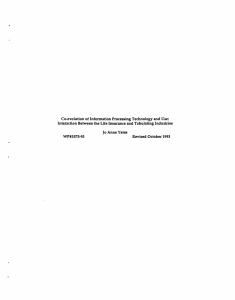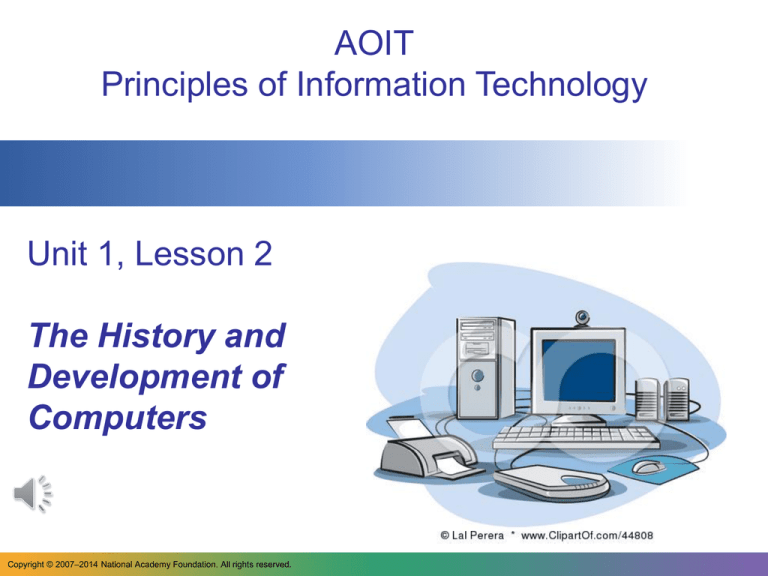
AOIT
Principles of Information Technology
Unit 1, Lesson 2
The History and
Development of
Computers
Copyright © 2007–2014 National Academy Foundation. All rights reserved.
The word computer has a broad meaning
What is a computer?
A computer is an instrument or machine
that gathers, processes, and stores information.
2
Early counting methods were very basic
• The first counting tools were people’s own fingers. The
word digit can refer to a finger (or toe) or to a single
character in a number system.
• Bones with carved notches have been found in Europe,
dated between 30,000 to 20,000 BCE. One had
notches in groups of five—early evidence of the tally
system.
• When you use objects instead of fingers to count, you
can store results for later reference.
3
The abacus was the first calculator
• The abacus was invented around 3,000 BCE in
Babylonia.
• Early abaci used small stones or pebbles lined up
in columns in the sand.
• A modern abacus has rings or beads that slide
over rods in a frame.
4
Early calculators used decimals
• In the 1670s, Gottfried Leibniz invented the
Stepped Reckoner, a machine for multiplication,
division, and square roots.
• Although Leibniz’s machine used the decimal
number system (with 10 values), he advocated
the use of the binary number system with two
values: 0 and 1.
What Counting to 10 Looks Like
Decimal:
Binary:
0, 1, 2, 3, 4, 5, 6, 7, 8, 9, 10
0, 1, 10, 11, 100, 101, 110, 111, 1000, 1001, 1010
5
On a punch card, the presence or absence of
holes represents digital information
A punch card is a piece of stiff paper that has
predefined positions on it. Data is represented by
the presence or absence of a hole in each
predefined position.
6
Charles Babbage is called the “father of computing”
• Charles Babbage
designed a steampowered calculator
called the Difference
Engine in 1821.
• His next idea was the
Analytical Engine
(1856), designed to
perform any kind of
mathematical
calculation.
7
More inventions made communication easier
The 1800s brought many more inventions:
• 1837, first American telegraph (Samuel Morse)
• 1850, the first key-driven adding machines
• 1857, punched paper tape used to send messages
• 1867, the first marketable typewriter
• 1879, the first mechanical cash register
8
Ada Byron was the first computer programmer
Ada Byron, a friend
of Babbage, wrote an
analysis of the
Analytical Engine in
which she outlined
computer
programming basics.
9
Tabulating machines improved data gathering
In 1890, Herman Hollerith created
an electric tabulating machine for the
US Census Bureau, the Hollerith
desk.
The desk had a device to “read”
or sense the holes in punch cards,
a gear-driven mechanism that could
count, and a wall of dials to show
results.
Hollerith formed the Tabulating
Machine Company in 1896. It later
became known as International
Business Machines (IBM).
10
Konrad Zuse made the first programmable digital
computer
• During World War II, Konrad Zuse, a German
engineer, created a series of computers: the Z1,
Z2, Z3, and Z4.
• The Z3 was the first fully programmable, digital
computing machine.
11
British Colossus decoded messages during WWII
• In 1943, the British built the first “Colossus”
computer.
• These machines were used to decipher encrypted
teleprinter messages sent by the Germans during
World War II.
12
Integrated circuits eliminated the need to
assemble discrete components
• In an integrated circuit, all the components and
the chip are made out of the same block of
semiconductor material.
• Over time, integrated circuits have continued to get
smaller in size but larger in capacity.
Old integrated
circuit with thin
wires going to
connection pins
Microchips with
clear windows that
show the integrated
circuit inside
Modern microprocessor
integrated circuit with
connection wires to the
13
outside of the package
The Altair was the first computer sold to individuals
• The Altair, designed for
hobbyists, was sold by
mail order beginning in
1975.
• Since there was no
keyboard or screen,
information was entered
by clicking switches on
the front of the machine.
• This was the beginning
of the microcomputer
revolution.
14
The first Apple computer was introduced in 1976
Apple I
Apple II
• In 1976 Steve Wozniak created the first personal
computer, called the Apple 1, with a built-in
keyboard, display screen, and storage unit. Steve
Jobs decided to market it.
• The Apple II was first produced in 1977.
15
The first IBM PC was released with an open
architecture that others could copy
• In 1981, IBM introduced
its version of the
personal computer: the
IBM PC.
• The open architecture
meant that the general
design was available to
competing companies.
This resulted in many
clones or compatibles.
16
Today’s PCs come in many sizes and models
• Desktop computers were
the first computers that
could fit on a desk.
• Notebook or laptop
computers are portable.
• Tablet PCs are notebooks
that use a touch screen or
stylus instead of a mouse
and keyboard.
• Smartphones are handheld
computers integrated with a
mobile phone.
17
A workstation is the most powerful type of PC
• Workstations are PCs with high-speed processors,
lots of storage, and special equipment such as
hardware to enable extensive graphics capabilities.
• Workstations are commonly used by professionals
such as engineers, scientists, and video editors.
The Apple workstation
The Radius LE workstation
is easy to transport
18
Servers are more powerful than workstations
• Servers work on a
network.
• They are designed to
run for a long time
without turning off.
• Hardware and software
in a server must be
extremely reliable so
that a business doesn’t
lose data or have
downtime for repairs.
19
Supercomputers are the most powerful computers
• Supercomputers are the
fastest computing systems,
used to perform a huge
number of calculations at
the same time.
• Legacy supercomputers
are very large, with many
processors inside.
• Most modern supercomputers
are highly tuned computer
clusters with custom
interconnects between
computers in the cluster.
Lawrence Livermore
National Labs’ IBM
“Sequoia” supercomputer
20
What is in the future for computers?
•
Give some ideas what computers will
be 20 years from now?
• Size
• Type
• Speed
• Connectivity
• Cost
21

